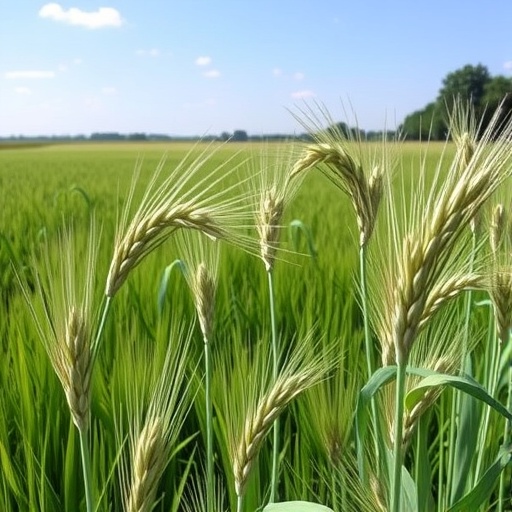In an era where agriculture grapples with mounting environmental challenges, the study of crop resilience takes on immense significance, especially in the context of increasingly toxic soils and emerging plant pathogens. Recent research has shed light on the tolerance mechanisms of oats against cadmium—a heavy metal contaminant—and powdery mildew, a fungal disease that jeopardizes yield and quality. The study, conducted by renowned scientists including Kubová, Langraf, and Lengyelová, offers a comprehensive analysis of how oats withstand such adversities, opening up new avenues for sustainable agriculture.
The increasing global reliance on cereals highlights the urgent need for resilient varieties capable of thriving in contaminated environments. Cadmium, a widespread pollutant found in agricultural soils, stems from various sources including industrial emissions and the excessive use of fertilizers. This toxic metal poses significant risks not only to plant health but also to human well-being, as it accumulates within the food chain. Consequently, understanding the physiological and biochemical responses of crops to cadmium stress is more crucial than ever.
Oats, a cereal grain with excellent nutritional properties, represent a promising focal point for research aimed at uncovering mechanisms of tolerance against cadmium. The study by Kubová and her colleagues meticulously dissects the pathways by which oats manage to survive in polluted soils, highlighting both genetic and physiological adaptations. The researchers embarked on a path to quantify the levels of cadmium uptake and accumulation in oats, along with the corresponding changes in growth patterns and biochemical responses.
One significant revelation from their findings is how certain oat varieties exhibit varying degrees of tolerance to cadmium. This variability underscores the potential for conventional breeding practices to enhance cadmium resistance in oats. For instance, specific genotypes were found to possess elevated levels of antioxidants that mitigate oxidative stress induced by cadmium exposure. These antioxidants, including glutathione and superoxide dismutase, play pivotal roles in neutralizing harmful reactive oxygen species generated in plants under heavy metal stress.
Beyond cadmium, the research explored the impact of powdery mildew, a pervasive fungal disease that affects numerous crops worldwide. This pathogen not only reduces yield but also compromises the overall health of plants. By examining the interactions between oats and the powdery mildew fungus, Kubová et al. aimed to understand how these resilient plants could fend off such threats while concurrently managing heavy metal stress.
One of the crucial mechanisms identified in the study is the plant’s innate immune response, a complex network of signaling pathways that activate defense mechanisms upon pathogen recognition. The researchers elucidated how oats initiate these responses, effectively creating a barrier against fungal invasion. Molecular markers associated with resistance to powdery mildew could potentially be utilized for developing disease-resistant oat varieties, thereby contributing to more sustainable agricultural practices.
Moreover, the study emphasizes the importance of soil health in crop resilience. Healthy soil microbiomes can enhance nutrient availability and improve plant stress tolerance. The interplay between heavy metals and soil microorganisms becomes a vital aspect of maintaining agricultural productivity in contaminated areas. Kubová and her team call for further investigation into the role of beneficial microbes in promoting cadmium detoxification processes in crops, an area that promises to yield innovative solutions.
The findings of this research not only provide insights into the physiological underpinnings of metal tolerance in oats but also highlight critical strategies for integrating bioengineering approaches to foster more resilient agricultural systems. Genetic modification techniques could expedite the development of oat varieties engineered for enhanced resistance to cadmium and pathogens, adding a vital tool in the global effort to combat food insecurity.
Furthermore, public awareness of the implications of heavy metal pollution and the resulting need for crop resilience is imperative. Policymakers and agricultural stakeholders must collaborate to implement strategies that support sustainable farming practices. The potential for oats to thrive in adverse conditions offers a beacon of hope in the fight against food shortages exacerbated by industrial pollution and climate change.
In conclusion, the research undertaken by Kubová, Langraf, and Lengyelová underscores the intricate dance of resilience that oats perform amid the dual threats of cadmium toxicity and powdery mildew infection. This pioneering study contributes significantly to our understanding of plant adaptations in the face of environmental challenges, paving the way for the future of sustainable agriculture that harmonizes crop production with environmental health.
As the findings echo through the scientific community, they serve as a clarion call to prioritize research into crop resilience. The journey towards food security in a changing world depends on our ability to harness science, breeding, and ecological insights to cultivate crops that not only nourish us but also thrive in our increasingly polluted environment.
In summation, the concerted efforts of researchers like Kubová and her colleagues sheds light on the critical intersection of environmental science and agricultural innovation. As the world witnesses escalating climate threats and soil degradation, the quest for resilient crops like oats is not merely academic; it represents a practical pathway toward sustainable food systems that can weather the storms to come.
Subject of Research: Oat tolerance mechanisms against cadmium and powdery mildew
Article Title: Study of selected mechanisms of oat tolerance to cadmium and powdery mildew.
Article References:
Kubová, V., Langraf, V., Lengyelová, L. et al. Study of selected mechanisms of oat tolerance to cadmium and powdery mildew.
Environ Sci Pollut Res (2025). https://doi.org/10.1007/s11356-025-36951-x
Image Credits: AI Generated
DOI: 10.1007/s11356-025-36951-x
Keywords: cadmium, powdery mildew, oat tolerance, heavy metal stress, sustainable agriculture, plant resilience.




